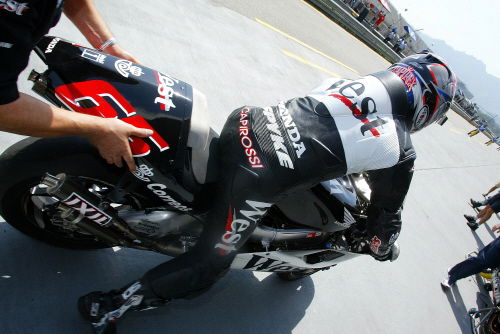All smiles as Pons join 4-stroke party.
No wonder Antonio Cobas is smiling - at last his West Honda Pons team are starting a grand prix on a level playing field.
On Sunday at Motegi in Japan, they join the four-stroke brigade for the first time when Alex Barros rides the RCV Honda four-stroke after 12 previous races attempting to stay with the 990cc five-cylinder flyers that have dominated the first year of the new MotoGP World Championship.

No wonder Antonio Cobas is smiling - at last his West Honda Pons team are starting a grand prix on a level playing field.
On Sunday at Motegi in Japan, they join the four-stroke brigade for the first time when Alex Barros rides the RCV Honda four-stroke after 12 previous races attempting to stay with the 990cc five-cylinder flyers that have dominated the first year of the new MotoGP World Championship.
Barros will ride the RCV machine on Sunday, after some superb performances on the NSR 500cc two-stroke Honda. The Brazilian's fourth place in the championship puts him easily the best two- stroke of the season so far and his reward - a ride on the machine that has only been beaten once in 12 grands prix this season.
''I'm looking forward to working with the four-stroke although I really don't know what to expect,'' revealed Technical Director Cobas. ''It's very important for us to start understanding the machine in order to be ready for next season. I will be the only person involved in both the four-stroke RCV of Alex and the NSR two-stroke of Loris Capirossi because the rest of the team will look after their own rider. I will really enjoy trying to understand the problems of the four-stroke and it should be a very interesting weekend.''
To be honest, there have not been many problems with the RCV Honda this year and Barros's four-stroke experience in the Suzuka Eight Hour race means he should take to the machine like a duck to water.
The World 250cc Champion Daijiro Kato rode into second place at the Czech Republic Grand Prix last month, making his debut on the RCV. Ironically, that was the only time the Honda has not won a grand prix this season with Max Biaggi bringing Yamaha their only victory of the year so far.
Apart from that slight blip, it's been victory all the way for the RCV with Italian Valentino Rossi clinching the first MotoGP world title in Brazil last week when he won his tenth grand prix of the season. Apart from the Biaggi defeat, the only other person to take the chequered flag in front of Rossi was his team-mate Tohru Ukawa, who took advantage of a mistake by the champion on the last lap of the Africa's Grand Prix.
So what makes the RCV 211V Honda four-stroke, which only made its public debut at Motegi a year ago with Honda's favourites sons Mick Doohan and Freddie Spencer in control, such a world- beater. As with any successful machine it's not one single factor but a package of innovative ideas and features that have produced a truly remarkable racing motorcycle.
Where do you start?
The 990cc four-stroke engine is a very compact unit that churns out an incredible 225bhp, which produces a top speed of around 320kmh. The RCV's narrow 75.5 degree angle allows a much shorter engine layout.
There are four main bearings on the forward-spinning crank with two outer pairs of cylinders each mounted on single crankpins, with the fifth cylinder mounted centrally on it's own crankpin. The motor is so compact it can be mounted in the frame in a way that greatly improves the machine's overall handling.
A revolutionary dry sump prevents oil starvation under heaving braking, constant cornering and quick acceleration and allows the oil reservoir to be positioned in the transmission cavity rather than the crankcase. The dry sump also reduces oil drag, reduces pumping loss, stabilises the oil level and reduces the size and weight of the engine.
Two fuel injectors are controlled by a computer run engine management system. They are situated upstream and downstream of the throttle valve. The downstream injector controls low to middle range throttle response while the upstream injector controls flat out throttle response resulting in highly linear response coupled with high power output. Also featured is a variable fuel pressure mechanism which supplies a highly precise fuel supply volume thus improving throttle control. The Attached Fuel Control System achieves an optimal air/fuel mixture that significantly improves both rideability and fuel consumption.
The brand new Unit Pro-Link suspension system only connects to the main chassis at the swing arm pivot and one other point. The elimination of the upper frame mount helps with the bike's centre of gravity and also allows a fuel tank to be fitted under the seat. Chatter problems have been reduced due to the new flexible chassis, without deep beams sections and makes the machine easier to ride.
The new advanced CAD simulated designed swinging arm produces the best of both worlds. It's laterally more flexible than its NSR counterpart but torsionally more rigid.
It's the complete package that's only 18 months ago was still on the drawing board. The other manufacturers are flat-out in their efforts to match the world's first V-five motorcycle but they still have a long long way to go.
You have the feeling after reading all that and glancing at the MotoGP results this season that Antonio Cobas could have an even bigger grin on his face after the 25-lap race on Sunday at the Motegi home of Honda.


